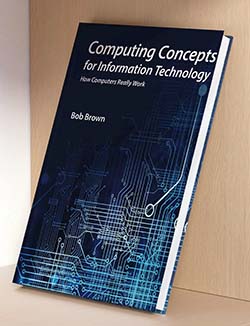Computing Concepts for
Information Technology
An understandable introduction to computers, hardware, software, and networks.
Computing Concepts is number 7 on BookAuthority's "10 Best New Technology Books To Read In 2024."
This is an eBook available free in PDF form to professors and educational institutions although a license is required. There is also a print edition for those who want a “real book.” That necessarily costs a small amount of money. The book in electronic form is available for Kindle, Apple Books, or Google Books.. Each chapter has been reviewed by a peer and a subject matter expert, and proofread by at least one person who’s not me.
Most people know how to use a computer, and many can write computer programs (code), but how does the computer turn that code into all the wonderful things it can do? Computing Concepts for Information Technology explains, in approachable language, how computers really work, including how images, sounds, and video are represented by numbers and how chips with millions of transistors process those numbers.
Computing Concepts for Information Technology is suitable for people with no prior study of computer systems, although it may be helpful to have experience with a high-level programming language such as Java or Python.
Computing Concepts for Information Technology tells a story that begins in the 19th century and shows that the Internet, phones, tablets, and laptops that are so much a part of our lives did not spring fully formed from a Silicon Valley campus. On the inside, computers are all about numbers, and the story continues with numbers and number systems. It reveals the mysteries of binary numbers and explains why computers use a number system different from the one we use every day. One of the reviewers of the book remarked that students of computing should know enough about the digital logic that makes computers work to believe that what’s inside is not little green Martians with calculators, and the book provides a thorough explanation.
Input and output, data communications, computer software, and information security are covered at a fundamental level and provide the necessary background for further study.
The beginning of the 21st century is an exciting time for those who make, use, and study computers and computer systems, and this book provides the basis for keeping up with the changes that are taking place right now.
Computing Concepts for Information Technology is suitable for people with no prior study of computer systems, although it may be helpful to have experience with a high-level programming language such as Java or Python.
Computing Concepts for Information Technology tells a story that begins in the 19th century and shows that the Internet, phones, tablets, and laptops that are so much a part of our lives did not spring fully formed from a Silicon Valley campus. On the inside, computers are all about numbers, and the story continues with numbers and number systems. It reveals the mysteries of binary numbers and explains why computers use a number system different from the one we use every day. One of the reviewers of the book remarked that students of computing should know enough about the digital logic that makes computers work to believe that what’s inside is not little green Martians with calculators, and the book provides a thorough explanation.
Input and output, data communications, computer software, and information security are covered at a fundamental level and provide the necessary background for further study.
The beginning of the 21st century is an exciting time for those who make, use, and study computers and computer systems, and this book provides the basis for keeping up with the changes that are taking place right now.
